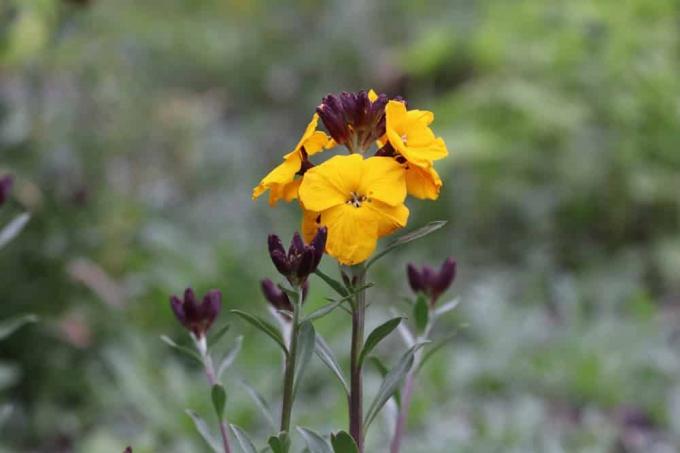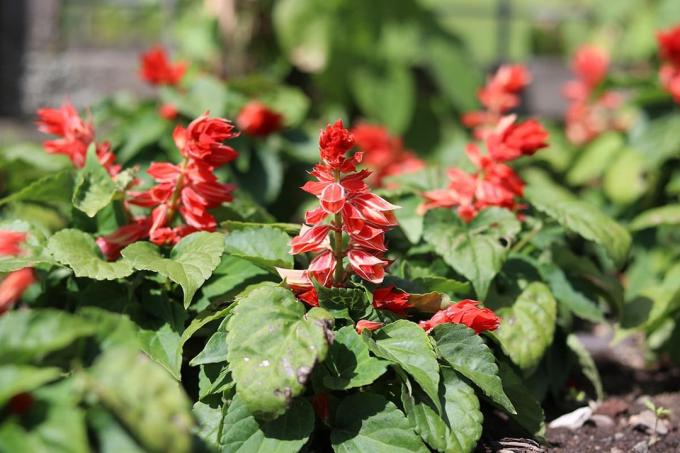

Table of contents
- Care
- Location
- watering and fertilizing
- Cut
- multiply
- sowing
- direct sowing
- cuttings
- hibernate
- Conclusion
With Schöterich, creative hobby gardeners decorate full sun, meager locations in their garden where many other perennials would quickly run out of breath. Thanks to its vigour, the bright orange Erysimum x allionii has the potential to cover larger areas. In small groups, as a solitaire or in a tub, the robust perennial adorns the rock garden just as effectively and emphasizes the visual appearance of a dry stone wall. Here you can find out how professional care is to be handled and how targeted pruning promotes flowering.
Care
The successful cultivation of Schöterich is based on the choice of a suitable location. This is followed by all other factors of skilful care.
Location
Any attempt to settle the frugal perennial in rich soil is doomed to failure from the outset. Mother Nature has created a variety of suitable plant species for these areas. In contrast, the priorities of Erysimum x allionii are here:
- Full sun, warm and sheltered position
- Lean, calcareous soil
- Well drained and dry
Schöterich develops its full splendor in the rock or gravel garden, in or on a dry stone wall. With its bright inflorescences, the cruciferous plant also comes into its own in planters. If commercially available potting soil is used as a substrate, it should be optimized by adding sand, perlite, expanded clay or lava granules. Ideally, you should put Schoterich in lean pricking or herb soil, which is already lean from home.
watering and fertilizing
In terms of water and nutrient supply, the orange ornamental plant rarely demands your attention. As a rule, it is content with the natural rainfall. Given the preferred lean soil conditions, fertilizer application is rarely required. However, it should not fail completely if lush flowering is desired.
- Water only during prolonged drought
- Start fertilizing in March in the form of long-term fertilizer or compost
- Fertilize with compost, guano or horn shavings every 4 weeks until August in the bed

In the narrow space of the bucket, however, regular watering and fertilizing is essential. Allow the substrate to dry thoroughly before watering the next time. A liquid fertilizer replenishes the depleted supply of nutrients every 2 weeks. In this case, make sure not to apply the preparation to dried-up soil. If necessary, first water with clear water. Alternatively, fertilizer sticks are used, which have to be replaced every 6 to 8 weeks.
Tip:
As a perennial perennial, Schöterich first develops its roots and foliage in the year of planting. The flowers do not unfold for the first time until the following spring.
Cut
To a certain extent, Schöterich has regenerative properties. This circumstance implies the ability to flower again after a targeted pruning. An 'intermediate cut' also prevents lignification, which counteracts compact growth. This is how you handle the topic of cutting Erysimum x allionii correctly:
- Shorten all stems by a third after the main bloom
- Cut the plants down to the ground before the first frost
- Until then, regularly clean out everything that has faded
If seeding is not desired, the autumn pruning takes place so early that the seed pods cannot develop. Otherwise, leave the withered parts on the plant for as long as possible as extra winter protection. In this case, only reach for the scissors in late winter on a frost-free day.
multiply
For the offspring of Schöterich both the generative propagation by sowing and the vegetative method by cuttings are available. Both methods are straightforward to execute, with the benefit of sowing being started during the quiet early spring period. In contrast, the cuttings method promises a varietal propagation.
sowing
If Erysimum x allionii are already cultivated in your garden, the mature pods will provide plenty of seeds for sowing. Harvest the fruits in time before they burst open. In a warm, airy place, the elongated pods dry quickly and release the numerous seeds. These should preferably be stored in a dark glass or plastic container in a cool cellar until next spring.
- In February, soak the seeds in water for 4-6 hours
- Fill a seed tray or pot with moist seed soil, peat sand or coconut fiber
- Scatter the seeds and sieve a thin layer of substrate or sand over them as dark germs
At a constant temperature of 18 to 20 degrees Celsius, germination begins within 4 weeks. Keep the substrate slightly moist without causing waterlogging. From a height of 5 centimeters, when at least two pairs of leaves have developed, the plantlets are isolated in pricking soil.
direct sowing

As an alternative to sowing behind glass, experienced hobby gardeners prefer direct sowing into the bed or planter. In the period from May to July, the time window is open for this variant of propagation.
- Deeply loosen the soil at the chosen location
- Remove weeds, stones and roots
- Optimize very sandy soil with sieved compost
- Flatten the surface with the rake and sow the seeds
- Cover with three times the seed strength of soil or sand and water
A close-meshed net serves to protect against hungry birds and pests. After four weeks, the young plants have developed so far that they are separated at a distance of 25 centimeters. During this phase, regular watering is essential for the root system to develop well.
Tip:
Repeated pinching of seedlings encourages further branching and a compact habit.
cuttings
Early summer is the best time to take cuttings. Choose a vital, healthy mother plant and proceed as follows:
- Cut non-flowering top cuttings with a length of 10-15 cm
- Defoliate the bottom half of the stem
- Fill small pots with moist potting soil to place a cutting in each
- Water regularly in a semi-shady location until the first shoots appear
If a young Schöterich has fully rooted its pot, plant it in the bed or bucket. Until the young plant is well established, continue the regular supply of water. Older Erysimum x allionii are only watered when it is dry.
hibernate

Since shady oaks are equipped with a conditional winter hardiness, minimal protection is recommended. This precaution should be taken especially in harsh environments. Regardless of whether the plants were cut back in the fall or not, they should be covered with brushwood in good time before the first frost. Ideally, heap the planting site with leaf soil. Ideally, take potted plants to a frost-free winter quarters. Alternatively, the planter is wrapped in bubble wrap and placed on a block of wood. The earth covers a layer of pine twigs or foliage. It is important to note that the plants should be watered when there is a frost. If the moistening snow cover falls while it is freezing at the same time, the perennials suffer from drought stress within a short time. Therefore, water on a frost-free day, but never with warmed water. The winter protection is removed in good time in early spring as soon as the mercury column permanently exceeds the zero degree mark. If the weather conditions are suitable, you can look forward to early flowering in sheltered locations.
Conclusion
Schöterich impresses with a bright orange flower and a delicate fragrance. Even the blazing sunshine does not cause this undemanding perennial any discomfort, but is welcomed with joy. As long as an Erysimum x allionii is allowed a place in poor, calcareous soil, it will tirelessly unfold its enchanting inflorescences from March to November. Care is limited to watering when it is dry and a little fertilizer every four weeks. Those who take the time to regularly clean and trim after the main flowering period will be rewarded with a particularly luscious blaze of colour.
 garden editorial
garden editorial I write about everything that interests me in my garden.
Learn more about perennials

20 hardy plants that bloom all year round
With plants that flower all year round, you can quickly create an attractive garden that does not require much maintenance, as long as the plants are also hardy. In this post, we will introduce you to 20 plants that are suitable for this.

17 flowering hardy plants May to October
Many plants only show their full splendor for a short time. But there are also types and varieties with a particularly long flowering period from May to October, sometimes even longer. We present 17 flowering hardy plants.

Hardy perennials: 22 perennial bloomers
Hardy perennials as permanent bloomers in the flower bed enchant the garden from early summer to autumn with a colorful bloom. They are easy to care for and magically attract butterflies, bees and the like.

10 care tips for the banana tree
If you like it exotic, cultivate a banana tree as a houseplant or in the conservatory. In summer, the banana plants are even allowed outside for a few weeks. The large leaves that the Musa forms on a false trunk are particularly decorative and impressive, and therefore look like a small tree.

Properly care for globe thistle | 10 tips for care
The globe thistle is an eye-catcher in the garden. Their spherical flowers provide a food source for insects. The globe thistle is not difficult to care for and it is suitable for dry locations. With a few tips on care, the plants will develop even better.

Fire sage, Salvia splendens: care from A to Z
Fire sage is known in botanical jargon as Salvia splendens and is a particularly decorative eye-catcher. But what kind of care does the plant need? Our guide to the salvia shows the important points from A to Z.



